Day-303 | Daily MCQs | UPSC Prelims | POLITY AND GOVERNANCE
[WpProQuiz 348]
[WpProQuiz 348]
THE CONTEXT: Australia has declared a state of emergency for the state of New South Wales (NSW) along with a catastrophic fire warning the highest level of bush fire danger in light of widespread bushfires that have left at least three people dead. Bushfires are a routine occurrence in the country, but this bushfire season is believed to be the worst and has started even before the beginning of the Southern Hemisphere summer.
AMAZON FOREST FIRE
CALIFORNIA FIRE
BANDIPUR NATIONAL PARK
Causes of forest fires can be divided into two broad categories
Environmental causes
Human related causes
Result from human activity as well as methods of forest management. These can be intentional or unintentional, for example:
Classification of Forest Fire Forest fire can broadly be classified into three categories;
Types of Forest Fire: There are two types of forest fire
Surface Fire
Crown Fire
EFFECT OF FOREST FIRE
Fires are a major cause of forest degradation and have wide ranging adverse ecological, economic and social impacts, including:
MoEFCC guidelines
MoEFCC issued a set of national guidelines for forest fire prevention and control in 2000. These guidelines call for:
National Master Plan for Forest Fire Control
The main objectives are:
Forest Fire Prevention and Management Scheme
In 2017, Intensification of Forest Management Scheme was revised and replaced as Forest Fire Prevention & Management Scheme. The main objectives of the scheme are as follows:
Pre-Warning Alert System
NDMA Guidelines
Major recommendations include:
Draft National Forest Policy, 2018
FAO Recommendations on Forest Fire Management
ISSUES AND CHALLENGES:
WAY FORWARD:
Policy
At the national level, a cohesive policy or action plan should be formulated to set forth the guiding principles and framework for FFPM. The policy and programmes for forest fire management should incorporate the dimension of climate change
Management
Forest fire prevention and management practices used by state forest departments also need to be strengthened
Funding and Human Resource
Greater funding for construction of watchtowers and crew stations and for frontline officers and seasonal firewatchers to spot fires is needed. Further, adequate training should be provided to field officers, seasonal firewatchers, and community volunteers involved in firefighting.
Technology
Modern firefighting techniques such as the radio-acoustic sound system for early fire detection and Doppler radar should be adopted.
Data and information
There is a need to support forest fire management through improved data and research to fill critical knowledge gaps
Awareness
Awareness generation for forest communities and visitors is important to prevent loss of life and injuries. Further, regular drills on escape methods and routes based on forest types should be conducted.
Best Practices:
1.Canadian Forest fire Danger Rating System:
2. Role of forest community: Best Practice in India:
CONCLUSION: A significant amount of technical options to assist Forest Department in increasing their resilience, preparedness and response capacities against forest fire are known and available at regional, national and international levels. However, the spectrum of available options is often not known or easily accessible. To make Forest Fire Management more effective, it is of utmost significance that available options are systematically assessed, documented, shared and adapted to location specific needs in a participatory way.
STATISTICAL REPORT:
Forest Fires Report in India:
Highlights:
What are the proposed reasons?
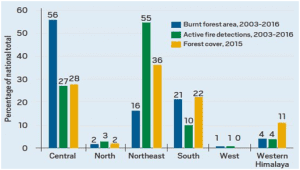
Significance:
THE CONTEXT: The Supreme Court of India has sought the most recent position of the Union government on a batch of petitions challenging the Constitution (Scheduled Castes) Order of 1950, which allows only members of Hindu, Sikh and Buddhist religions to be recognised as SCs.
THE EXPLANATION:
Who all are included in the Constitution Order of 1950?
• When enacted, the Constitution (Scheduled Castes) Order of 1950, initially provided for recognising only Hindus as SCs, to address the social disability arising out of the practice of untouchability.
• The Order was amended in 1956 to include Dalits who had converted to Sikhism and once more in 1990 to include Dalits who had converted to Buddhism. Both amendments were aided by the reports of the Kaka Kalelkar Commission in 1955 and the High Powered Panel (HPP) on Minorities, Scheduled Castes and Scheduled Tribes in 1983 respectively.
• On the other hand, the Union government in 2019 rejected the possibility of including Dalit Christians as members of SCs, rooting the exclusion on an Imperial Order of 1936 of the then colonial government, which had first classified a list of the Depressed Classes and specifically excluded “Indian Christians” from it.
Why are Dalit Christians excluded?
• Ever since the amendment to include Sikhs as SCs in 1956, the Office of the Registrar General of India (RGI) has been reluctant in expanding the ambit of the Order beyond members of Hinduism or Sikhism. Responding to the Ministry of Home Affairs’s (MHA) 1978 request for an opinion on the inclusion of Dalit Buddhists and Christians, the RGI had cautioned the government that SC status is meant for communities suffering from social disabilities arising out of the practice of untouchability, which it noted was prevalent in Hindu and Sikh communities.
• It also noted that such a move would significantly swell the population of SCs across the country. However, the amendment to include Buddhist converts as SCs was passed in 1990, which at the time did not require the approval of the RGI — a mandate introduced in the rules for inclusion framed in 1999.
• In 2001, when the RGI again opined against including Dalit Christians and Muslims as SCs, it referred to its 1978 note and added that like Dalit Buddhists, Dalits who converted to Islam or Christianity belonged to different sets of caste groups and not just one, as a result of which they cannot be categorised as a “single ethnic group”, which is required by Clause (2) of Article 341 for inclusion.
• Moreover, the RGI opined that since the practice of “untouchability” was a feature of Hindu religion and its branches, allowing the inclusion of Dalit Muslims and Dalit Christians as SCs could result in being “misunderstood internationally” as India trying to “impose its caste system” upon Christians and Muslims.
• The 2001 note also stated that Christians and Muslims of Dalit origin had lost their caste identity by way of their conversion and that in their new religious community, the practice of untouchability is not prevalent.
Is there a case for inclusion?
• The petitions arguing for inclusion have cited several independent Commission reports that have documented the existence of caste and caste inequalities among Indian Christians and Indian Muslims, noting that even after conversion, members who were originally from SCs continued to experience the same social disabilities.
• This was substantiated in the First Backward Classes Commission’s report in 1953, the Report of the Committee on Untouchability Economic and Educational Development Of the Scheduled Castes in 1969, the HPP report on SCs, STs, and Minorities in 1983, the Mandal Commission Report, the report of the Prime Minister’s High-Level Committee formed in 2006, a 2008 study conducted by the National Commission for Minorities, the Ranganath Misra Commission Report and several other studies.
• In addition to this, the petitions have argued against the proposition that caste identity is lost upon conversion, noting that even in Sikhism and Buddhism, casteism is not present and yet they have been included as SCs. Furthermore, the above-mentioned reports argue that caste-based discrimination continues even after conversion, hence entitling these communities to SC status.
• However, the Union government refuses to accept the reports of the Commissions on the basis that these reports do not have enough empirical evidence to support their claims.
THE CONTEXT: According to opposition party, a revamp of the Standing Committees of Parliament could potentially worsen the relations between the government and opposition parties.
THE EXPLANATION:
Of the 22 committees announced the Congress has the post of chairperson in only one, and the second largest opposition party, Trinamool Congress, none. The ruling NDA has the chairmanship of the important committees on Home, Finance, IT, Defence and External Affairs.
What are Committees of Parliament, and what do they do?
• Legislative business begins when a Bill is introduced in either House of Parliament. But the process of lawmaking is often complex, and Parliament has limited time for detailed discussions. Also, the political polarization and shrinking middle ground has been leading to increasingly rancorous and inconclusive debates in Parliament — as a result of which a great deal of legislative business ends up taking place in the Parliamentary Committees instead.
• A Parliamentary Committee is a panel of MPs that is appointed or elected by the House or nominated by the Speaker, and which works under the direction of the Speaker. It presents its report to the House or to the Speaker.
• Parliamentary Committees have their origins in the British Parliament. They draw their authority from Article 105, which deals with the privileges of MPs, and Article 118, which gives Parliament authority to make rules to regulate its procedure and conduct of business.
What are the various Committees of Parliament?
• Broadly, Parliamentary Committees can be classified into Financial Committees, Departmentally Related Standing Committees, Other Parliamentary Standing Committees, and Ad hoc Committees.
• The Financial Committees include the Estimates Committee, Public Accounts Committee, and the Committee on Public Undertakings. These committees were constituted in 1950.
• Seventeen Departmentally Related Standing Committees came into being in 1993, when Shivraj Patil was Speaker of Lok Sabha, to examine budgetary proposals and crucial government policies. The aim was to increase Parliamentary scrutiny, and to give members more time and a wider role in examining important legislation.
• The number of Committees was subsequently increased to 24. Each of these Committees has 31 members — 21 from Lok Sabha and 10 from Rajya Sabha.
• Ad hoc Committees are appointed for a specific purpose. They cease to exist after they have completed the task assigned to them, and have submitted a report to the House. The principal Ad hoc Committees are the Select and Joint Committees on Bills. Committees like the Railway Convention Committee, Committee on Food Management and Security in Parliament House Complex, etc. also come under the category of Ad hoc Committees.
• Parliament can also constitute a Joint Parliamentary Committee (JPC) with a special purpose, with members from both Houses, for detailed scrutiny of a subject or Bill. Also, either of the two Houses can set up a Select Committee with members from that House. JPCs and Select Committees are usually chaired by ruling party MPs, and are disbanded after they have submitted their report.
How important are the recommendations of the Committees?
• Reports of Departmentally Related Standing Committees are recommendatory in nature. They are not binding on the government, but they do carry significant weight. In the past, governments have accepted suggestions given by the Committees and incorporated them into the Bill after it has come back to the House for consideration and passage. These panels also examine policy issues in their respective Ministries and make suggestions to the government.
• The government has to report back on whether these recommendations have been accepted. Based on this, the Committees table Action Taken Reports, detailing the status of the government’s action on each recommendation.
• However, suggestions by the Select Committees and JPCs — which have a majority of MPs and heads from the ruling party — are accepted more frequently.
THE CONTEXT: According to a new World Bank report, titled “Poverty and Shared Prosperity 2022: Correcting Course”, the Covid pandemic has been the biggest setback to global poverty alleviation in decades.
THE EXPLANATION:
According to the report, “The world is unlikely to meet the goal of ending extreme poverty by 2030 absent history-defying rates of economic growth over the remainder of this decade”.
What has the report found?
• The report states that global poverty reduction has been slowing down since 2015 but the Covid pandemic and the war in Ukraine have completely reversed the outcomes.
• By 2015, the global extreme-poverty rate had been cut by more than half. Since then, poverty reduction has slowed in tandem with subdued global economic growth. The economic upheavals brought on by COVID-19 and later the war in Ukraine produced an outright reversal in progress.”
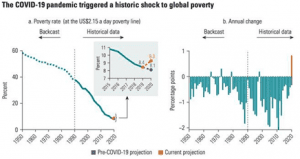
• As such, the global goal of ending extreme poverty by 2030 would not be achieved.
• In 2020 alone, the number of people living below the extreme poverty line rose by over 70 million; the largest one-year increase since global poverty monitoring began in 1990. As a result, an estimated 719 million people subsisted on less than $2.15 a day by the end of 2020.
• Inequalities, too, have risen the poorest people bore the steepest costs of the pandemic: income losses averaged 4 per cent for the poorest 40 per cent, double the losses of the wealthiest 20 per cent of the income distribution. Global inequality rose, as a result, for the first time in decades.
• Global median income declined by 4 per cent in 2020—the first decline since measurements of median income began in 1990.
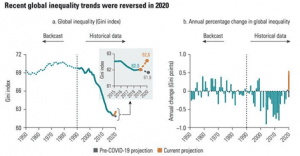
What about India’s poverty levels?
Poverty has gone up in India too.
• “Previous estimates suggested a poverty headcount rate at the US$1.90 poverty line of 10.4 percent in 2017…The latest estimate based on Sinha Roy and van der Weide (2022) shows that poverty at the US$1.90 poverty line was 13.6 percent in 2017,” finds the report.
• However, the report uses data from Centre for Monitoring Indian Economy (CMIE), because there are no official estimates of poverty available since 2011.
• “The most recent survey data released by the National Sample Survey Office of India used to measure poverty is the 2011/12 National Sample Survey (NSS). The government decided not to release the 2017/18 NSS round because of concerns about data quality,” it states.
• But it could not have left India out of the poverty estimates simply because India is one of the countries with the biggest poor population. “Because of India’s size, the lack of recent survey data for the country significantly affects the measurement of global poverty, as was evident in Poverty and Shared Prosperity 2020.”
• It states that given the country’s size and importance for global and regional poverty estimates, the CMIE data helps fill an important gap.
What are the suggested solutions?
• According to President of World Bank Group, “fiscal policy—prudently used and considering the initial country conditions in terms of fiscal space—does offer opportunities for policy makers in developing economies to step up the fight against poverty and inequality”.
• To be sure, the average poverty rate in developing economies would have been 2.4 percentage points higher without a fiscal response. Yet government spending proved far more beneficial to poverty reduction in the wealthiest countries, which generally managed to fully offset Covid-19’s impact on poverty through fiscal policy and other emergency support measures.
• Developing economies had fewer resources and therefore spent less and achieved less: upper-middle-income economies offset just 50 per cent of the poverty impact, and low- and lower-middle income economies offset barely a quarter of the impact.
The World Bank has three specific suggestions when it comes to fiscal policy.
1: Choose targeted cash transfers instead of broad subsidies.
2: Prioritize public spending for long-term growth.
3: Mobilize tax revenues without hurting the poor.
THE CONTEXT: The grouping of the world’s largest oil-producing countries, the Organisation of the Petroleum Exporting Countries (OPEC) and its allies, together known as OPEC+, decided to cut oil production by 2 million barrels per day (bpd).
THE EXPLANATION:
• According to sources, this is the largest cut since the beginning of the Covid-19 pandemic. Brent crude, the international benchmark, was up 28 cents or 0.3%, at $92.08 a barrel after the cut was announced.
• In light of recent falling gas prices, OPEC+ officials had decided in September to reduce oil output by a modest 100,000 bpd after they first agreed in the previous month to increase production by the same amount.
What is OPEC+?
• Established in 1960 by founding members Iran, Iraq, Kuwait, Saudi Arabia and Venezuela, OPEC has since expanded and now has 13 member states. With the addition of another 11 allied major oil-producing countries that include Russia, the grouping is known as OPEC+.
• The objective of the organisation is to “coordinate and unify the petroleum policies of its Member Countries and ensure the stabilisation of oil markets in order to secure an efficient, economic and regular supply of petroleum to consumers, a steady income to producers and a fair return on capital for those investing in the petroleum industry”.
• Previously controlled by western-dominated multinational oil companies known as the “Seven Sisters,” OPEC sought to give the oil-producing nations greater influence over the global petroleum market. They account for roughly 40 per cent of the world’s crude oil and 80 per cent of the globe’s oil reserves, according to estimates from 2018. They usually meet every month to determine how much oil the member states will produce.
• However, many allege that OPEC behaves like a cartel, determining the supply of oil and influencing its price in the world market.
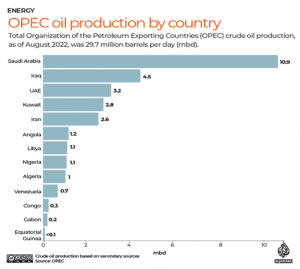
Why are they slashing production?
• Oil prices skyrocketed after Russia’s invasion of Ukraine in February, and have since begun to soften over the past few months, before dropping sharply to under $90 in September due to fears of a recession in Europe and reduced demands from China because of its lockdown measures.
• Today’s cut is the biggest of its kind since 2020 when OPEC+ members slashed outputs by 10 million bpd during the Covid-19 pandemic, Reuters reported. The reductions would boost prices and be extremely beneficial for the Middle Eastern member states, to whom Europe has turned for oil after levelling sanctions against Russia since it invaded Ukraine.
• OPEC+ members are concerned that a faltering global economy would reduce the demand for oil, and the cuts are seen as a way to protect profits. Increased oil prices, which first occurred during the invasion of Ukraine, have helped Saudi Arabia, one of the founding members of OPEC, become one of the world’s fastest-growing economies.
THE CONTEXT: Scientists have genetically modified mosquitoes to slow the growth of malaria-causing parasites in their guts — an advancement that can help prevent transmission of the disease to humans.
THE EXPLANATION:
• The disease is transmitted between people through a female mosquito after it bites someone infected with the malaria parasite. The parasite develops into its next stage in the mosquito’s gut and travels to its salivary glands, ready to infect the next person it bites.
• Now, the mosquitoes have been engineered to produce compounds that slow the growth of malaria-causing parasites.
• Though only around 10 per cent of mosquitoes live long enough for the infectious parasite to develop, malaria remains one of the most devastating diseases globally, putting at risk about half of the world’s population. In 2021, it infected 241 million people and killed 627,000 people.
The research
• Researchers from the Institute for Disease Modelling at the Bill and Melinda Gates Foundation developed a model to assess the impact of such modifications and found it could be effective even where transmission is high. While the technique, described in a paper published in Science Advances journal on September 21, has been shown to dramatically reduce the possibility of malaria spreading in a lab setting, if proven in the real world it could offer a powerful new tool to help eliminate malaria.
• Researchers from the Transmission: Zero team at Imperial College London, UK, genetically modified the main malaria-carrying species of mosquito in sub-Saharan Africa, Anopheles gambiae, such that the mosquito produced antimicrobial peptides in its gut when it had a blood meal.
How it works
• The peptides impair the malarial parasite’s development and also cause the mosquitoes to have a shorter life span. The co-first author of the study, Tibebu Habtewold, said new tools are increasingly needed as mosquitoes develop resistance to insecticides and treatments.
• To prevent malaria spread via genetic modification, the change needs to be spread from lab-bred mosquitoes to wild ones. The innovation is so designed that it can be coupled with existing ‘gene drive’ technology.
• “Gene drive is one such powerful weapon that in combination with drugs, vaccines and mosquito control can help stop the spread of malaria and save human lives,” study co-lead author Professor George Christophides said. Gene drive would cause the anti-parasite genetic modification to be preferentially inherited, making it spread more widely among any natural populations.
Applicability
• It would, however, require extremely careful planning to minimise risks before any field trials. The Transmission:Zero team is, therefore, creating two separate but compatible strains of modified mosquitoes — one with the anti-parasite modification and one with the gene drive.
• They can then test the anti-parasite modification on its own first, adding in the gene drive once it has been shown to be effective. With partners in Tanzania, the team set up a facility to conduct some first tests. They are also risk-assessing potential releases of modified mosquitoes and taking into account potential hazards, but are hopeful that their intervention can help eradicate malaria.
THE CONTEXT: The 2022 Nobel Prize in Chemistry has been awarded to chemists Carolyn R. Bertozzi and K. Barry Sharpless from the U.S., and Morten Meldal from Denmark, for their work in the field of click chemistry and bioorthogonal chemistry.
THE EXPLANATION:
• Dr. Sharpless was the first scientist to work on what is today called click chemistry – a branch of science that explores the assembly of molecules. In fact, this is not his first Nobel Prize in Chemistry. He previously won the award in 2001.
What is click chemistry?
• In simple terms, click chemistry is a functional field where molecules snap together quickly and efficiently – literally like a click.
• Dr. Sharpless talked about the field in the research paper in 2001, where he defined it as a “set of powerful, highly reliable, and selective reactions for the rapid synthesis of useful new compounds and combinatorial libraries through heteroatom links”. In the same paper, he talked about the need to develop synthetic strategies instead of trying to imitate naturally occurring compounds. He is of the view that even if click chemistry is unable to provide exact replicas of natural molecules, it can help find molecules that fulfil the same purpose.
• According to Dr. Sharpless, a reaction should be able to occur in the presence of oxygen and in water for it to be called that of click chemistry.
The need for click chemistry
• Replicating reactions that involve bonds between carbon atoms – that are vital to the existence of life – is expensive and often leads to side reactions and loss of material. Instead of trying to make carbon atoms react with each other, Dr. Sharpless’s research focuses on using smaller molecules that already have a complete carbon frame, The Nobel Foundation noted. These molecules can further be linked using oxygen or nitrogen atoms as bridges. Simpler reactions, “where there is a strong intrinsic drive for the molecules to bond together”, may avoid the loss of material as well as the unwanted side reactions.

POLITY AND GOVERNANCE
SOCIAL ISSUES
INTERNATIONAL ISSUES
ECONOMIC DEVELOPMENT
ENVIRONMENT AND ECOLOGY
SCIENCE AND TECHNOLOGY
SECURITY
ETHICS EXAMPLES AND CASE STUDY
QUOTATIONS AND CAPTIONS
ESSAY TOPIC
50-WORD TALK
Things to Remember:
[WpProQuiz 347]
THE CONTEXT: The recent incidents of landslides in Himalayan states and the Western Ghats have again put the spotlight on the need for early detection, warning, and prevention systems and adopting sustainable solutions for better management of landslides disasters in India. This article analyses causes, impact & suggestive steps regarding Landslides.
WHAT IS A LANDSLIDE?
RECENT LANDSLIDE DISASTERS
ü On 26th July, nine people lost their lives when a landslide suddenly flung boulders down a hill in Himachal Pradesh’s Kinnaur district.
ü On 18th July 18, a series of landslides in two areas of Mumbai claimed at least 32 lives.
ü On 14th July, five died in HP’s Kangra district after heavy rainfall triggered floods and landslides.
IMPORTANT FACTS RELATED TO LANDSLIDE RISK IN INDIA
WHY DO THE HIMALAYAS EXPERIENCE MORE LANDSLIDES THAN THE WESTERN GHATS?
MAJOR LANDSLIDE PRONE AREAS OF INDIA
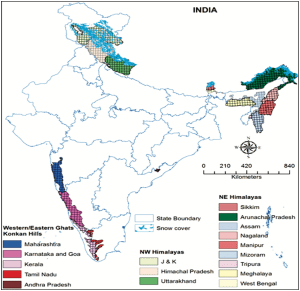
HUMAN INTERVENTION
UNPLANNED DEVELOPMENT, FLAWED REGULATIONS
EXTREME WEATHER
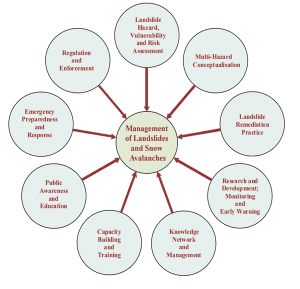
LANDSLIDE HAZARD, VULNERABILITY, AND RISK ASSESSMENT
MULTI-HAZARD CONCEPTUALISATION
LANDSLIDE REMEDIATION PRACTICE
RESEARCH AND DEVELOPMENT; MONITORING AND EARLY WARNING
KNOWLEDGE NETWORK AND MANAGEMENT
PUBLIC AWARENESS AND EDUCATION
EMERGENCY PREPAREDNESS AND RESPONSE
HOW MAPPING LANDSLIDES CAN MINIMISE DAMAGE
PLANNING AHEAD
MONITORING FOR EARLY WARNING
SWISS MODEL
ü The extensive forest cover of Switzerland has developed only over the last 160 years.
ü Before that, only about 4% of that country’s lands had retained forest and there were disastrous landslides.
ü This led to a public awakening and a restoration of the tree cover.
ü This regeneration was managed by local communities, not by government departments.
ü Working together, communities of Switzerland, practicing genuine participatory democracy, have revived the country’s ecology.
CONCLUSION: There is a cost to pursuing development goals without paying attention to environmental constraints. Therefore, development goals must be pursued without breaching environmental regulations. Recent devastating landslides signal the dire need for ramping up disaster alert systems while enhancing climate change mitigation efforts.
THE CONTEXT: With two of the five-member Supreme Court Collegium against a proposal to recommend four new judges to the top court through a written note instead of a formal meeting, Chief Justice of India U U Lalit is learnt to have written to them again, seeking reconsideration of their stand.
THE EXPLANATION:
The Collegium system
THE CONTEXT: In a significant judgment, the Supreme Court said it was unconstitutional to distinguish between married and unmarried women while allowing abortion when the foetus is between 20-24 weeks. Going a step further, the court said the term ‘woman’ in the judgment included persons other than cisgender women.
THE EXPLANATION:
What is cisgender?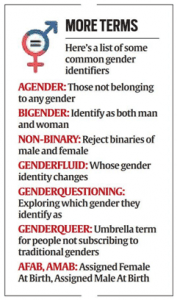
Cisgender: Origins of the term
Why the word cisgender is important?
Use of gender-inclusive vocabularies in official documents
Those who advocate the use of ‘birthing people’ say it is not just women who give birth. Transmen — a person assigned the female gender at birth but who identifies as a man – and genderqueer people – who identify as neither man nor woman – also give birth.
THE CONTEXT: The World Health Organization (WHO) has warned of a “worrying surge” in cholera cases across the globe.
THE EXPLANATION:
VALUE ADDITION:
About Cholera:
Cholera is an acute, diarrheal illness caused by infection of the intestine with the bacterium Vibrio cholerae. The infection is often mild or without symptoms, but sometimes can be severe.
How does a person get cholera?
Can cholera be treated?
THE CONTEXT: NIMHANS and HelpAge India are jointly implementing Sarthak to ensure mental well-being of elderly.
THE EXPLANATION:
Mental health situation among elderly
According to the NGO HelpAge, over 20 per cent of adults aging 60 and above suffer from a mental or neurological disorders like dementia and depression. During the pandemic, it found that in a sample size of 5,000 people, 60 per cent reported that they felt lonely and isolated. 40 per cent of them have felt depressed. This issue is expected to worsen in the coming years. The Longitudinal Ageing Study of India (LASI) report forecasted 14 million senior citizens in India will face mental health issues by 2050. This is a significant increase from the current figure of 5 million. Currently, in India, 2 in 10 people facing mental health issues are not receiving any kind of assistance to address mental health problems. There is only 1 psychiatrist for over 2 lakh people.
About NIMHANS
The Bengaluru-based National Institute of Mental Health and Neuro-Sciences (NIMHANS) is India’s apex centre for mental health and neuroscience education. It comes under the aegis of the Union Health Ministry and operates autonomously as the Institute of National Importance. The institute’s origin can be traced to the establishment of Bangalore Lunatic Asylum in 1847. The Indian Parliament had passed a law in 2012 to declare it as an Institute of National Importance.
THE CONTEXT: The Nobel Committee announced the names of three physicists as Nobel Laureates for this year. They are Alain Aspect from the University of Paris-Saclay, France; John F. Clauser of John F Clauser and Associates, California, USA; and Anton Zeilinger, University of Vienna, Austria.
THE EXPLANATION:
They have been awarded for “experiments with entangled photons, establishing the violation of Bell inequalities and pioneering quantum information science,” according to a press release by the Royal Swedish Academy of Sciences, which awards the Nobel Prizes every year.
The award

Breakdown of the classical
Trajectory and its absence
THE CONTEXT: Recently, the Former German Chancellor Angela Merkel recently received the Nansen Refugee Award.
THE EXPLANATION:
About Nansen Award
What is UNHCR?
The UNHCR is a UN agency involved in the protection of refugees and displaced and stateless communities. It is involved in their voluntary repatriation, local integration and resettlement in a foreign country.
THE CONTEXT: Recently, the U.S. Environmental Protection Agency (EPA) has pointed out that since the industrial revolution, human activities have released large amounts of carbon dioxide (CO2).
THE EXPLANATION:
Alarming Increase in Carbon Dioxide:
• Atmospheric carbon dioxide levels have increased by over 40%, from 280 ppm in the 18th century to 414 ppm in 2020, and greenhouse gases level by over these 200 years.
• Reason: Due to fuel burning and other ‘greenhouse gases’ such as methane, nitrous oxide, and compounds of sulphur, phosphorous, ozone into the atmosphere, changing the earth’s climate.
India Specific Observations:
• Rise in Greenhouse gases: The industrial revolution started only after India’s Independence 75 years ago which has led to a rise in atmospheric carbon dioxide and greenhouse gases.
• Need to Reduce Carbon Footprint in Farming Sector: India has a total food-grain production of 275 million tonnes. India is the second largest producer of rice, wheat, sugarcane, cotton and groundnuts. It, thus, becomes important that India try and reduce its carbon footprint as much as possible, more in its farming sector.
Innovative Initiatives in Agriculture to Reduce Global Warming
• Farmers are using solar panels in their fields, so that they can avoid diesel for groundwater pumps.
• Climate-friendly agriculture offers new income sources and is more sustainable and India’s carbon emissions could drop by 45-62 million tonnes annually.
• India has about 20-39% vegetarians and 70% of the population eat meat — mainly chicken, mutton and fish. India, with its many rivers, has a vast coastline which is rich in fishes and fishes have high nutritional value and help in reducing carbon footprint.
India’s Efforts
Updated Nationally Determined Contributions (NDCs):
• India now stands committed to reducing the emissions intensity of its GDP by 45 percent by 2030 from its 2005 levels, as per the updated NDC.
• The country will also target about 50 percent of cumulative electric power installed capacity from non-fossil fuel-based energy resources by 2030.
• To create an additional (cumulative) carbon sink of 2.5-3 gigatonnes of carbon dioxide equivalent (GtCO2e) by 2030 through additional forest and tree cover.
• To further a healthy and sustainable lifestyle, ‘LIFE’ ‘Lifestyle for Environment’ as a key to combating climate change” has been added to India’s NDC.
• The update is also a step towards achieving India’s long term goal of reaching net-zero by 2070.
Adaptation and Mitigation:
• The Government has launched many schemes and programs to scale up India’s actions on both adaptation and mitigation.
• Appropriate measures are being taken under these schemes and programs across many sectors, including water, agriculture, forest, energy and enterprise, sustainable mobility and housing, waste management, circular economy and resource efficiency, etc.
• As a result of the aforesaid measures, India has progressively continued decoupling of economic growth from greenhouse gas emissions.
Focus on Renewable Energy:
• The PM has set the targets and reiterated that the Indian government is committed to increasing the share of renewable energy in India’s total energy share. Initially, the target for renewable energy was set at 175 GW, but now it has been further revised to 450 GW by 2030.
• It will lead to an overall increase in green jobs such as in renewable energy, clean energy industries- in automotives, manufacturing of low emissions products like Electric Vehicles and super-efficient appliances, and innovative technologies such as green hydrogen, etc.
Mobilisation of Resources:
• India is earmarking a large part of its developmental resources to the fight against climate change.
• This is a stupendous effort as compared to the western countries, which are already at the advanced stages of development.
International Solar Alliance (ISA):
• ISA is a global alliance being initiated by India as well as headquartered in India. It is aimed at promoting research to develop more efficient, low-cost solutions to the global energy requirements, by leveraging advanced technology as well as providing incentives and regulation.
THE CONTEXT: The United Nations Conference on Trade and Development (UNCTAD) expects India’s economy to grow 5.7% in 2022 and 4.7% in 2023. India’s gross domestic product (GDP) grew 8.7% in FY22.
THE EXPLANATION:
• The UN report expects the world economy to grow 2.6% in 2022. This is 0.9 percentage points below last year’s projected rate. The growth is expected to further decelerate in 2023 to 2.2%. This would leave the real GDP below the pre-pandemic levels by the end of 2023.
• It warns that the rapidly increasing interest rates and fiscal tightening in the advanced economies, along with the Russia-Ukraine War, have already exacerbated the global slowdown into a global economic downturn.
• The advanced economies’ monetary and fiscal policies risk triggering a global recession and prolonging stagnation. This could lead to a situation worse than the 2008 financial crisis and the 2020 COVID-19 induced shock.
• The report holds that attempting to curb inflation by increasing interest rates is an impudent gamble and would lead to a recession.
• Excessive monetary tightening, especially given the current situation of declining real wages, financial turbulence and insufficient support and coordination from multilateral forum, could lead to stagnation and instability in many developing economies as well as some developed ones.
• The report expects the Indian economy, the largest in the region, to grow 5.7% in 2022 and 4.7% in 2023. In FY22, the country’s GDP grew 8.7%.
• The country’s economic activity is being affected by weaker public expenditure and higher financing costs, according to the 2022 report. While the government plans to boost capex, especially in the road and rail sectors, the weakening global economy will put pressure on the policymakers to reduce the fiscal imbalances. This would reduce expenditure elsewhere.
ABOUT:
United Nations Conference on Trade and Development (UNCTAD)
The Geneva-based UN body has been releasing this report since 1981 to provide analysis the major current economic trends and policy issues of global concern. It provides recommendations to boost the global economy so that lives of people are improved and the future of the planet is secure.
THE CONTEXT: In a big boost to Aatmanirbhartha in Defence, Raksha Mantri presided over the formal induction of Light Combat Helicopter (LCH), designed and developed by Hindustan Aeronautics Limited (HAL), into the Indian Air Force (IAF) in Jodhpur.
THE EXPLANATION:
Naming LCH as “Prachanda”, Raksha Mantri said that its induction comes during the Amrit kal when the Nation is celebrating Azadi ka Amrit Mahotsav and a pointer to the future when IAF will be the top most force in the world, as also making the country fully AatmaNirbhar in Defence production requirements. Raksha Mantri also took a sortie onboard the LCH shortly after its induction into IAF.
• The LCH was developed after around 20 years of research and development post Kargil War. The name Prachand means “fierce”. It was designed and developed by the state-owned defence company Hindustan Aeronautics Limited (HAL).
• The indigenous content in LSP version of the helicopter accounts for the 45 per cent of the cost, which is expected to raise to more than 55 per cent in the production version of the series.
FEATURES:
• This indigenously developed 5.5 tonne class combat helicopter is equipped with numerous stealth features, armoured protection, night attack capability and landing gear capable of survival.
• It has extended range and high-altitude performance capability as well as the round-the-clock, all-weather combat capability. It is capable of neutralizing adversary air defence, conducting counter-insurgency operations and combat search and rescue (CSAR) operations. It is useful for conducting high-altitude bunker busting operations and counter-insurgency operations in jungle and urban terrains.
• It can also be used for countering slow-moving aircraft and remotely operated aircrafts. This helicopter can also provide assistance to ground forces during combat situations.
• Presently, the Indian Armed Forces is expected to require a total of 160 LCHs, of which 65 is for IAF and 95 is for the Indian Army. The HAL has now created a strategy to achieve the peak rate production capacity of 30 helicopters per annum to manufacture the remaining 145 of these combat helicopters in 8 years from the date of inking the series production order.
THE CONTEXT: Indore has been adjudged the cleanest city of India for the sixth year in a row, while Madhya Pradesh is the cleanest state in the country. Surat is the second cleanest city and Navi Mumbai comes a close third in the category of cities with a population more than a lakh.
THE EXPLANATION:
• In the population category of less than one lakh, Panchgani and Karad from Maharashtra bagged the first and third positions respectively, while Patan from Chhattisgarh bagged the second position.
• Tirupati received the best city award in Safai Mitra Suraksha category, while Haridwar in Uttarakhand received the award for the best Ganga town in more than one lakh population cities. Shivamogga in Karnataka received the fast mover city award.
• The State awards saw Madhya Pradesh emerge as the Cleanest State in the category of “more than 100 Urban Local Bodies”, relegating Chhattisgarh, the cleanest State of the previous three years, to second place. Maharashtra emerged as third cleanest State.
• Similarly, Tripura got the cleanest State award in the “less than 100 urban local bodies category”, dislodging Jharkhand, which had won in the past two consecutive years. Jharkhand and Uttarakhand received the second and third spots respectively.
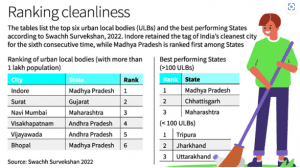
VALUE ADDITION:
Swachh Survekshan:
• Swachh Survekshan, conducted by MoHUA since 2016, is the world’s largest urban sanitation and cleanliness survey.
o It is being conducted under the ambit of the Swachh Bharat Mission (Urban)2.0.
• It has been instrumental in fostering a spirit of healthy competition among towns and cities to improve their service delivery to citizens and towards creating cleaner cities.
• It aims to encourage cities to improve the status of urban sanitation while encouraging large scale citizen participation.
THE CONTEXT: A new catfish species has been discovered in the river Cauvery near Mettur Dam.
THE EXPLANATION: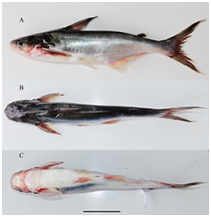
• The edible species has been named Pangasius icaria ( P. icaria) after the Indian Council of Agricultural Research that discovered the species. The species belongs to the Pangasius genus.
• The genus Pangasius is found in the Gangetic plains but not in peninsular India.
• Through this study, they found that Pangasius specimens from the river Cauvery are different from other species of the genus Pangasius.
• The new species is edible and the locals call it keluthi in Tamil.
• Catfish has high commercial value in aquaculture and wild capture fisheries.
THE CONTEXT: Swedish scientist Svante Pääbo has been awarded the Nobel Prize for Physiology for the year 2022 “for his discoveries concerning the genomes of extinct hominins and human evolution.”
THE EXPLANATION:
• Through his pioneering research, Svante Pääbo – this year’s #NobelPrize laureate in physiology or medicine – accomplished something seemingly impossible: sequencing the genome of the Neanderthal, an extinct relative of present-day humans.
accomplished something seemingly impossible: sequencing the genome of the Neanderthal, an extinct relative of present-day humans.
• “Through his groundbreaking research, Svante Pääbo established an entirely new scientific discipline, paleogenomics. Following the initial discoveries, his group has completed analyses of several additional genome sequences from extinct hominins. Pääbo’s discoveries have established a unique resource, which is utilized extensively by the scientific community to better understand human evolution and migration.
• New powerful methods for sequence analysis indicate that archaic hominins may also have mixed with Homo sapiens in Africa. However, no genomes from extinct hominins in Africa have yet been sequenced due to accelerated degradation of archaic DNA in tropical climates.

[WpProQuiz 346]
THE CONTEXT: Recently, the NGT has directed the state government of Odisha to revive Sukapaika River within 6 months.
THE EXPLANATION:
ABOUT THE RIVER:
Sukapaika is one of the several distributaries of the mighty Mahanadi river in Odisha. It branches away from the Mahanadi at Ayatpur village in Cuttack district and flows for about 40 kilometres (km) before rejoining its parent river at Tarapur in the same district. In the process, it drains a large landmass comprising over 425 villages under 26 gram panchayats in three blocks.
THE CONTEXT: In a significant move to boost India’s defence export, the country has signed an export order for missiles, rockets, and ammunition to Armenia because the Asian nation is engaged in a border conflict with Azerbaijan.
THE EXPLANATION:
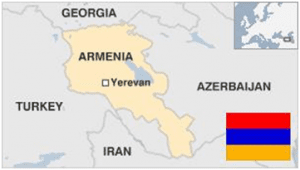 of arms and ammunition to Armenia.
of arms and ammunition to Armenia.About Pinaka multi-barrel rocket launcher
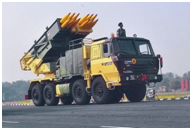 especially at the international borders with Pakistan and China.
especially at the international borders with Pakistan and China.THE CONTEXT: Thousands of trees were illegally cut down in the Corbett Tiger Reserve by the Uttarakhand government for the implementation of a safari project.
THE EXPLANATION:
About Corbett Tiger Reserve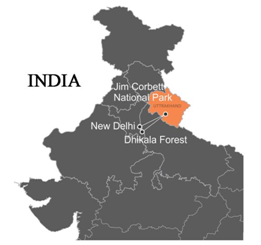
THE CONTEXT: A team of researchers has flagged the changing chemistry of the western region of the Arctic Ocean after discovering acidity levels increasing three to four times faster than ocean waters elsewhere.
THE EXPLANATION:
THE CONTEXT: The Ministry of Home Affairs (MHA) has extended the Armed Forces (Special Powers) Act (AFSPA) in parts of Arunachal Pradesh and Nagaland for another six months.
THE EXPLANATION:
About Armed Forces (Special Powers) Act 1958
Provisions:
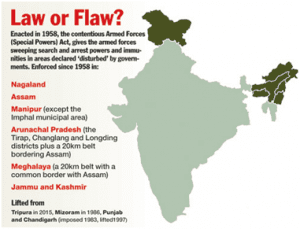 can declare the whole or part of the State or Union Territory as a disturbed area.
can declare the whole or part of the State or Union Territory as a disturbed area.Rationale behind its imposition
Criticisms
THE CONTEXT: The Ministry of Education launched YUVA 2.0 – Prime Minister’s Scheme for Mentoring Young Authors, a programme to train young and budding authors to promote reading, writing and book culture in the country, and project India and Indian writings globally.
THE EXPLANATION:
About PM-YUVA scheme
POLITY AND GOVERNANCE
SOCIAL ISSUES
INTERNATIONAL ISSUES
ECONOMIC DEVELOPMENT
SCIENCE AND TECHNOLOGY
ETHICS EXAMPLES AND CASE STUDY
QUOTATIONS AND CAPTIONS
50-WORD TALK
Things to Remember:
THE CONTEXT: Recently, torrential rains that took place in Hyderabad have caused massive urban floods. In many Indian cities, the urban floods have become a frequent phenomenon in recent years.The scale of destruction has been unprecedented. This experience is not unique to the city of Hyderabad but something that cities across India have been experiencing in recent years. This article discusses about the urban flooding, causes, impacts and the possible solutions.
Flooding in urban areas can be caused by flash floods, or coastal floods, or river floods, but there is also a specific flood type that is called urban flooding. It is different from normal floods, because
CAUSES
Natural causes
The rainfall received in Hyderabad in 2020 has been the highest for the month of October in a century.
Anthropological causes
Poor and old drainage system
Cities like Hyderabad, Mumbai rely on a century-old drainage system, covering only a small part of the core city.
Incremental land use change
Overlooking environmental regulations
Overlooking environmental regulations in mega-projects is fairly common in the country.
IMPACTS OF URBAN FLOODS
Holistic engagement
Developing Sponge Cities
Wetland Policy
There is a need to start paying attention to the management of wetlands by involving local communities.
EIAs and enforcement will remain vital to ensure that fragile wetlands and floodplains are not concretised.
Drainage planning
Water sensitive urban design
These can all be delivered effectively through an urban mission along the lines of the Atal Mission for Rejuvenation and Urban Transformation (AMRUT), National Heritage City Development and Augmentation Yojana (HRIDAY) and Smart Cities Mission.
CONCLUSION: Urban Flood management will not just help control recurring floods but also respond to other fault lines, provide for water security, more green spaces, and will make the city resilient and sustainable. We need to urgently rebuild our cities such that they have the sponginess to absorb and release water without causing so much misery and so much damage to the most vulnerable of our citizens
Urban flooding has become a common occurrence these days in India. The latest victim of urban flooding is Hyderabad.
Basic information-The city as well Telangana received unusually excessive rainfall October 13-14, 2020, due to a deep depression that developed in the Bay of Bengal. Heavy damage to property, roads and human lives has been reported.
The population of the city has grown exponentially. It is 10 million today.
Geographical setting- Hyderabad is located on the banks of the Musi river. The Himayat Sagar and Osman Sagar dams on the river, supply the water to the city.
Based on hydrology, present-day Hyderabad can be divided into Krishna and Godavari basins. Traditionally, all the rainwater falling in the catchment areas of Musi would discharge into Musi which is one of the 22 tributaries of the Krishna river. And newer localities to the west of Hyderabad, including Gachibowli and the IT corridor, are all in the catchment areas of the Godavari.In both Krishna and Godavari basins, the city has a network of lakes and drains which carry the excess water from one to another and then finally into the Musi and Majeera rivers.
Over the years, owing to the expansion of the city, the lakes were not in demand for their primary purposes of irrigation and drinking water. But they continued to be relevant for flood regulation.
Issue-The city of Hyderabad doesn’t usually get flooded due to monsoonal rain, which is spread over a long period. There is a natural system of flow of water from a high elevated area to a lower one. But Lakes in the town have shrunk due to encroachment. Discharge of sewage and industrial effluents, encroachments by government and private individuals, and decades of neglect had everyone thinking the river would never flow again. Most of the former waterways are open sewers now. But, on October 13, the river was in spate once again after a record downpour. Low-lying localities and colonies that were built on the lake beds and nullahs were submerged in no time. Many days later, hundreds of these colonies were still under water.
Large water bodies that existed for centuries have shrunk in size, encroachments have eaten into natural waterways, and stormwater drains get easily clogged.
Losses-As many as 33 lives have been lost to heavy rains and floods in the city, with the GHMC estimating that at least 37,409 families have been affected. The Municipal Administration minister pegged the city’s losses at Rs 670 crore.
Basic information-The 2005 Maharashtra floods impacted many parts of the Indian state of Maharashtra including large areas of the metropolis Mumbai, a city located on the coast of the Arabian Sea, on the Western coast of India. The floods were caused by the eighth heaviest-ever recorded 24-hour rainfall figure of 944 mm (37.17 inches) which lashed the metropolis on 26 July 2005, and intermittently continued for the next day.
Approximately 1,094 people died and city of Mumbai came to a standstill due to flooding.
Issues
Basic information-Chennai received 1,049 mm (41.3 in) of rainfall in November, the highest recorded since November 1918 when 1,088 mm (42.8 in) in of rainfall was recorded. On 1 December, heavy rains led to inundation in many areas of Chennai.
Chennai is built on flat coastal floodplains. Wetlands – including natural and artificial drains are the city’s insurance against heavy rains and cyclonic storm surges.
Issues-A study revealed how the city’s built-up area grew nine-fold – from 47 sq km in 1980 to 402 sq km in 2012 – even while area under wetlands declined from 186 sq km to 71 sq km during the same period. Between 1996 and 2015, more than 1,000 acres of this wetland was allegedly illegally diverted to accommodate industrial installations belonging to state-owned companies, including a large port and several coal-fired power plants.
The 2015 rains crippled the neighbourhoods drained by the creek. Some went under because power plants, coal ash ponds and coal yards blocked the flowing run-off from their habitations to the creek. Others were harmed by waters backing up far inland because their natural holding area – the backwaters – had been eaten into. The floods brought the refinery to a halt.
A parliamentary committee that enquired into the cause of the 2015 floods was categorical in its report that “encroachment of lakes and riverbeds played a major role in causing massive floods in Chennai”.
Impact-Power supplies were suspended to 60% of the city while several city hospitals stopped functioning. The Southern Railways cancelled major train services and Chennai International Airport was closed until 6 December.
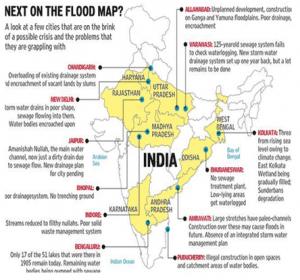
[WpProQuiz 345]